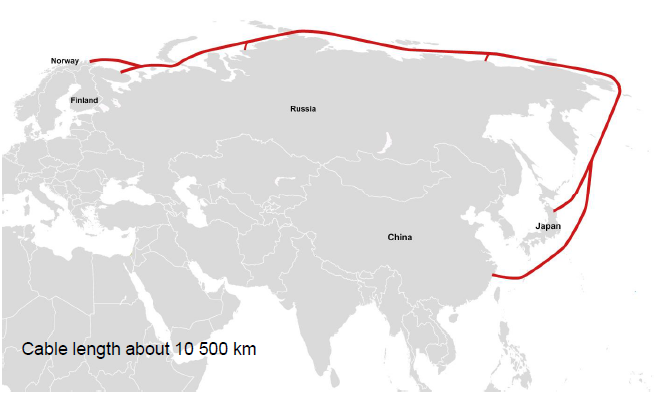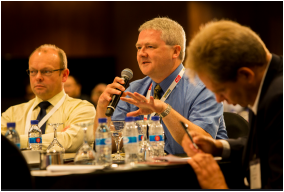|
Constructing a telecommunications cable between Europe and Asia via the North-East Passage would be politically and technologically feasible, says a report presented to Finland's Minister of Transport and Communications, Anne Berner, by former Prime Minister of Finland, Paavo Lipponen, and Managing Director of the Finnish Federation for Communications, Reijo Svento. If the project was carried out, the cable would significantly speed up telecommunications between Europe and Asia and respond to the increasing capacity needs. It would also benefit the national economies in Europe, Russia and Asia. Figure 10 - North-East Passage Cable Map Source: Swedish Ministry of Transport and Communications
According to the report, the key countries, among them Russia, China, Japan and Norway, would be interested in being involved in the project. A number of businesses were contacted during the course of the report's preparation. "Every country agreed with the need for the project and was ready to treat official permits, for example, favorably. Private financing for the project and the real business opportunities it would open up were also considered important," Lipponen says. "The report emphasizes that this technologically challenging project would have to be neutral in terms of both technology and the project parties so that it would provide equal benefits for everyone involved. All implementation stages would have to based on open competitive bidding," Svento says. The challenges that came up during the study are related to such matters as information security and project financing. The company that would be responsible for the telecommunications should be neutral and able to ensure protection of privacy. Commercial parties have wanted to ensure that there are no political barriers to the implementation of the project. The rapporteurs have presented a number of measures to promote the project. The key countries should be informed of the positive approach towards the project that has now been achieved. The project should be on the agendas of international meetings and should be given strong preference during the Finnish Chairmanship of the Arctic Council as of spring 2017. The next step would be to establish a multinational project or company for taking the project forward. Funding of around EUR 4–6 million would presumably be needed for completing this stage and making more precise plans. "I am committed to taking the project swiftly forward. The project is of great significance to banks, games industry and international development of the internet of things, for example. As a link between the North-East Passage and Baltic Sea cables Finland would have an excellent opportunity to become an international data traffic node," says Finland's Minister of Transport and Communications Anne Berner. The submarine section of the cable would be a connection of around 10,500 km from Japan and China to Kirkenes in Norway and the Kola Peninsula in Russia. The project implementation is expected to take several years. Source: www.lvm.fi ANALYSIS: The idea of building a submarine fiber optic cable to connect Europe to Asia via the Arctic Ocean was originally floated about fifteen years ago by a Russian company called "PolarNet". A marine survey was completed showing that the geology and bathymetry were feasible but the Russians struggled to gain commercial support. Fresh from their success in building the "C-Lion" submarine cable system from Finland to Germany, the Finnish Government, fronted by Cinia, is keen to take advantage of their momentum and further develop their vision of Finland as a hub for data transfer and storage. With the Finns in control, the North-East Passage Cable Project has a far greater chance of success than its predecessor. The really critical factor for success in this project will be to obtain and retain the support of the Russians who are notorious for shooting themselves in the foot when lucrative opportunities present themselves. This tendency is heightened by the aggressive / defensive stance of the current Russian Government. Moreover, the further the distance from Moscow, the less governance there is and, with the cable planned to go through sensitive environmental and militarily strategic regions, there is significant potential for corruption masked as bureaucracy. The study calls for the establishment of "a neutral multinational project or company" to develop and commercialize the project. This will probably be best achieved with the formation of a traditional submarine cable consortium. This model will not lead to the shortest lead time for development but it will spread the risk among a large number of interested parties and assign responsibility for permitting and landing the cable in territorial waters to members from each country, reducing the risk that the project will be hijacked by a corrupt entity. JRC estimates that the cost of this project would be in the region of US$500M but a positive return on investment is likely to result because of the proven growth in demand for connectivity between Europe and Asia and because this system would undoubtedly reduce latency between Western European states and East Asian countries, compared with traditional Asia-Europe submarine fiber optic routes via the Mediterranean, Red Sea, and Indian Ocean. Moreover, this route would avoid the stranglehold that Egypt exerts over cables traversing its territory. Russia would not have the same opportunity since the main trunk would not have to come onto Russian land. Asia-Europe cables that have followed the traditional route suffer from frequent outages as a result of having to share the route with shipping. The North-East Passage cable would be far less exposed to this risk. In addition to incumbent telecom operators and other large telecom carriers, it is likely that the content providers, e.g. Google, Facebook, Microsoft, Amazon, Baidu, and TenCent, will be interested in this project. Hopefully, with this large pool of potential participants, the consortium will find sufficient expertise to successfully implement an ultra-long haul submarine fiber optic consortium cable.
0 Comments
Leave a Reply. |
Julian Rawle, AuthorThought leadership articles and commentary on developments related to the subsea fibre optic cable industry can be found here. Archives
February 2018
Categories |




 RSS Feed
RSS Feed